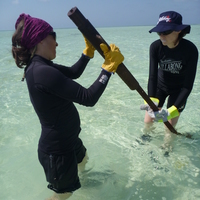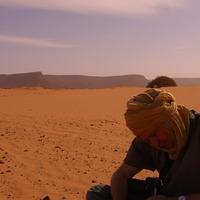Papers by Gerard Cabezas-Guzmán
Ancient Society, 2022
The war reparations extracted by Rome from the Corsicans as a result of their rebellions being de... more The war reparations extracted by Rome from the Corsicans as a result of their rebellions being defeated by the praetors M. Pinarius in 181 bc and C. Cicereius in 173 bc were in the form of hundreds of thousands of pounds of beeswax. This, to us rather unexpected, form of payment can be shown to relate to beeswax being an essential material used in the construction and maintenance of naval vessels. In this period, Rome had a very pressing need to acquire something as simple as beeswax, and in huge quantities, as it was crucial for Rome to be able to expand and maintain naval fleets operating simultaneously in different areas of the Mediterranean and against different threats. Without the wax, the capability and scope of the fleets would have been very greatly diminished and highly restricted, with significant adverse consequences for Rome and its ambitions.

Ventós, G. and Cabezas-Guzmán, G. (2022), "Ligurians, Gatekeepers of the West 197–118 BC ", in T. Ñaco del Hoyo, J. Principal, M. Dobson (eds.), Rome and the North-Western Mediterranean integration and connectivity, Oxbow Books, 47-57. To date, Rome's intervention to the West from the mid-second century BC, has not really been look... more To date, Rome's intervention to the West from the mid-second century BC, has not really been looked at with any sense of overview. Instead, there has been an unconnected series of micro-regional studies looking at particular areas, from the river Ebro in Spain round to Italy on the land front, and from the Balearic Islands to Corsica, Sardinia and even Sicily as regards the seaborne aspect. In contrast, the aim of this volume is to push the historical and archaeological debates about Rome's expansion, beyond these traditional geographical boundaries and the discipline-based previous research. The entire northwestern Mediterranean is treated as a micro-region, and is addressed using various interdisciplinary approaches. The result, is to provide an innovative and comprehensive overview of the northwestern Mediterranean in a period of historical crossroads, aided particularly by focusing on the connectivity and integration within this region as two interrelated issues. While Republican Rome enforced itself as an expansive power towards the West, all sorts of polities, military operations and individuals also played a signifi cant role in creating interconnectivity and integration of the northwestern Mediterranean into a new hybrid reality. In order to uncover such processes of hybridisation, contributors to this volume were encouraged to focus on the historical, archaeological and numismatic material from several areas within the region, and to incorporate aspects of interdisciplinary methodologies, in order to address the region's military, political, social and economic interconnections with Italy, Rome and each other, within the overall period.

To date, Rome's intervention to the West from the mid-second century BC, has not really been look... more To date, Rome's intervention to the West from the mid-second century BC, has not really been looked at with any sense of overview. Instead, there has been an unconnected series of micro-regional studies looking at particular areas, from the river Ebro in Spain round to Italy on the land front, and from the Balearic Islands to Corsica, Sardinia and even Sicily as regards the seaborne aspect. In contrast, the aim of this volume is to push the historical and archaeological debates about Rome's expansion, beyond these traditional geographical boundaries and the discipline-based previous research. The entire northwestern Mediterranean is treated as a micro-region, and is addressed using various interdisciplinary approaches. The result, is to provide an innovative and comprehensive overview of the northwestern Mediterranean in a period of historical crossroads, aided particularly by focusing on the connectivity and integration within this region as two interrelated issues. While Republican Rome enforced itself as an expansive power towards the West, all sorts of polities, military operations and individuals also played a signifi cant role in creating interconnectivity and integration of the northwestern Mediterranean into a new hybrid reality. In order to uncover such processes of hybridisation, contributors to this volume were encouraged to focus on the historical, archaeological and numismatic material from several areas within the region, and to incorporate aspects of interdisciplinary methodologies, in order to address the region's military, political, social and economic interconnections with Italy, Rome and each other, within the overall period.
Latomus. Revue d'Études Latines, 2021
Federico russo, La tutela degli edifici nelle città dell'impero romano in età antonina. Considera... more Federico russo, La tutela degli edifici nelle città dell'impero romano in età antonina. Considerazioni in margine a D.
In Republican Rome there seemed to be a symbiotic relationship between apparently different phen... more In Republican Rome there seemed to be a symbiotic relationship between apparently different phenomena: the results of ad hoc pillaging (i.e. spoils), both public and private supply requirements, and finally the compensation for the military personnel involved in such actions. In this chapter, however, the accent will be placed on the relationship between those three factors in a single geographical setting – the Iberian Peninsula – during the first fifty years of Roman military intervention.
ABANTOS. Homenaje a Paloma Cabrera Bonet, 2021
El objeto del presente artículo es dar a conocer una pieza singular hallada en las antiguas excav... more El objeto del presente artículo es dar a conocer una pieza singular hallada en las antiguas excavaciones de la ciudad grecorromana de Ampurias: una plaqueta de hueso, de pequeñas dimensiones, que representa, en relieve, la proa de una nave de guerra con gran precisión y detalle. Seguramente formaba parte de un grupo iconográfico de inspiración militar más complejo que decoraba la estructura de un lectus.
New Classicists Journal, King's College London, 2021
Guerra y Tecnología. Interacción desde la Antigüedad al Presente , 2017
Phicaria. VI Encuentros Internacionales del Mediterráneo. Navegar el Mediterráneo , 2018
The first Punic war (264-241 BCE) was a war between the maritime power of the western Mediterrane... more The first Punic war (264-241 BCE) was a war between the maritime power of the western Mediterranean, Carthage, and the Italic land power, Rome, by the dominion of Sicily. In order to impose its control on the island, the Italian metropolis had to charter several fleets and confront them with the experienced Punic endowments. Although Rome finally won, it had to face the challenges of a war at sea.
Historiae, 2013
Logistics is a key issue for an army in campaign any time. However, it was even more relevant whe... more Logistics is a key issue for an army in campaign any time. However, it was even more relevant when troops were forced to travel 1,500 kms. through enemy territory, up to the surroundings of their enemy, Rome, and that happened during the Hannibalic War. This paper, therefore, aims to show the logistic difficulties experienced by Hannibal's army during his first years in Italy.
Editorial Team by Gerard Cabezas-Guzmán
by Revista Universitaria de Historia Militar, Ángel Alcalde, Mario Lafuente Gómez, José Luis Ledesma, Javier Rodrigo, Alejandro M Rabinovich, Assumpta Castillo Cañiz, Gerard Cabezas-Guzmán, Javier Bustillo, GONZALO BUTRON PRIDA, Carlos Heredia, and Fernando Puell http://ruhm.es/index.php/RUHM/about
Book Reviews by Gerard Cabezas-Guzmán
RUHM, 2016
Review of the work of Dexter Hoyos, A Companion to Roman Imperialism.
Incidenza Dell'Antico , 2014
Review of the work of Claudio Vacanti, Guerra per la Sicilia e guerra della Sicilia. Il ruolo del... more Review of the work of Claudio Vacanti, Guerra per la Sicilia e guerra della Sicilia. Il ruolo delle città siciliane nel primo conflitto romano-punico.
Conference Presentations by Gerard Cabezas-Guzmán










Uploads
Papers by Gerard Cabezas-Guzmán
Editorial Team by Gerard Cabezas-Guzmán
Book Reviews by Gerard Cabezas-Guzmán
Conference Presentations by Gerard Cabezas-Guzmán
La present jornada de recerca dona a conèixer l'extensió de la influència romana en els territoris de l'occident romà sumats al seu domini. Per a exercir un control efectiu i dinàmic de l'expansió de la República, Roma va transformar el paisatge a la seva conveniència. Ports, ciutats i vies es multiplicaven en un extens embull sota l'aprovació de les elits urbanes beneficiades de la seva construcció i posterior aprofitament comercial. La constatació d'un nou poder en aquestes regions a través de la seva monumentalització també va ser una mostra del poder romà, deixant segurament sorpresos als habitants de l'àmbit rural. Aquesta tercera reunió és una extensió dels interessos debatuts en "Conquesta i colonització de l'Occident romà: producció i dinàmiques socials" i "Retrobades Epigràfiques: producció i menjar al món romà", on la projecció extrapeninsular i la transformació de Roma en potència internacional van tenir un profund impacte en el seu funcionament polític i en les estructures socioeconòmiques de la societat romana. A l'ampli esforç polític-militar se li va unir el necessari desenvolupament de noves formes institucionals en relació amb el control del seu territori, alterant consensos i poders anteriors en funció de nous mecanismes de control poblacional i territorial.
The analysis of inscriptions within the category of the instrumentum impressum inscriptum has focused the interest of many researchers of different nationalities, whose efforts have allowed us to discover ever larger sets of epigraphic documents. To the process of cataloging unpublished materials, we must add the continuous attempts made by researchers with the aim of resolving the meaning of these documents, which are in most cases abbreviated. In this sense, it is entirely normal to find different interpretations of the same inscription. Further collaboration with specialists on the epigraphy of the instrumentum will make it possible to share the advances and strategies of the study in order to obtain the most information possible from the messages that these inscriptions contain, as well as to trace the potential existence of patterns within the large data sets of productions that are the same, or similar.
Among the general objectives, the meeting aims to stimulate the presentation of new hypotheses concerning the function of these stamps, the importance of each of the traceability phases, which agents (producers or traders) are associated with their use, and the current problems presented by the research. Among the specific objectives, we intend to discuss the processes of production, marketing and distribution of containers and their contents in certain sectors of the Roman economy, reconstructing specific socioeconomic dynamics, at different scales and with a marked interprovincial character.
autochthonous societies (both individuals and groups) show the complex interactions generated between the political, social and economic spheres between the 3rd century BC and the 1st century AD.
This renewal of ideas and hypotheses has benefited from a growing mass of documentary material, made up of inscriptions of all kinds and new categories of material culture, which have been analyzed with new methodologies, from archeometry to statistics, with the management procedures of big data. Likewise, it is necessary to consider the possibilities offered by diverse perspectives, theoretical approaches and conceptual tools, from globalization to the theory of complex systems.
This is the context in which the meeting 'Conquest and colonization of the Roman West: production and social dynamics' takes place. Its general objective is to analyze the interactions between the production and distribution dynamics generated in the provincial space and Italy as a whole, taking the Iberian Peninsula as a case study. As specific objectives, its first intention is to discuss the production and distribution processes in certain sectors of the peninsular economy; second, to reconstruct specific socio-economic dynamics on a regional scale, assessing the possibility of defining spaces other than simple administrative frameworks for analysis; finally, the relations between regional economies, and between these economies, Italy, and other areas of the western Mediterranean, will be addressed. Consequently, it intends to offer a space for debate on perspectives and methods, rather than a simple state of the art. The congress brings together specialists from various fields who work together in an interdisciplinary manner.
****
En els darrers anys, les dinàmiques de la producció i la distribució de manufactures i aliments a la Mediterrània antiga han rebut una creixent atenció per part d'historiadors de l'antiguitat i arqueòlegs. Aquest interès s'explica per diversos factors. En primer lloc, la creixent atenció concebuda a l'economia romana, que s'ha percebut com un sistema complex, amb les seves pròpies dinàmiques de desenvolupament tecnològic i la seva pròpia racionalitat, diferent a altres economies preindustrials. El resultat d'aquest esforç ha estat la superació d'antics debats sobre la naturalesa de l'economia romana; un debat, en el fons, sobre la modernitat de la societat romana. En segon lloc, l'anàlisi de les dinàmiques econòmiques que van acompanyar l'expansió romana permet abordar, des d'una perspectiva postcolonial, el debat entorn de la naturalesa i la profunditat de les transformacions socioeconòmiques de les societats mediterrànies, superant els plantejaments culturals associats a terme "romanització ". Factors com les possibilitats d'explotació, la tributació, els desplaçaments de població (de les que la colonització oficial són només un component) o les diverses formes d’agency de les societats autòctones (d'individus i grups) mostren les complexes interaccions generades entre les esferes política, social i econòmica entre els segles III aC i I dC.
La renovació d'idees i hipòtesis s'ha beneficiat d'una creixent massa documental formada per inscripcions de tot tipus i noves categories de cultura material, que han estat analitzades amb noves metodologies, des de l'arqueometria a l'estadística, passant pels procediments de gestió de Big Data. Igualment, cal tenir en compte les possibilitats que ofereixen perspectives, plantejaments teòrics i eines conceptuals diverses, des de la globalització a la teoria dels sistemes complexos.
La reunió Conquesta i colonització de l'Occident romà: producció i dinàmiques socials es planteja en aquest context. El seu objectiu general és analitzar les interaccions entre les dinàmiques de producció i distribució generades en l'espai provincial i Itàlia, prenent la península Ibèrica com a cas d'estudi. Com a objectius específics, es pretén, en primer lloc, discutir sobre els processos de producció i distribució en certs sectors de l'economia peninsular; en segon, reconstruir les dinàmiques socioeconòmiques concretes, a escala regional, valorant la possibilitat de definir espais d'anàlisi diferent dels simples marcs administratius; finalment, s'analitzaran les relacions entre economies regionals i entre aquestes i Itàlia i altres àrees de la Mediterrània occidental. Es pretén, en conseqüència, oferir un espai de debat sobre perspectives i mètodes, abans que un simple estat de la qüestió. El workshop reuneix especialistes de diversos àmbits que treballen en clau interdisciplinària.
***
En los últimos años, las dinámicas de la producción y la distribución de manufacturas y alimentos en el Mediterráneo antiguo han recibido una creciente atención por parte de historiadores de la antigüedad y arqueólogos. Este interés se explica por diversos factores. En primer lugar, la creciente atención concedida a la economía romana, que se ha percibido como un sistema complejo, con sus propias dinámicas de desarrollo tecnológico y su propia racionalidad, diferente a otras economías preindustriales. El resultado de este esfuerzo ha sido la superación de antiguos debates sobre la naturaleza de la economía romana; un debate, en el fondo, sobre la modernidad de la sociedad romana. En segundo lugar, el análisis de las dinámicas económicas que acompañaron la expansión romana permite abordar, desde una perspectiva postcolonial, el debate en torno a la naturaleza y la profundidad de las transformaciones socioeconómicas de las sociedades mediterráneas, superando los planteamientos culturales asociados al término “romanización”. Factores como las posibilidades de explotación, la tributación, los desplazamientos de población (de las que la colonización oficial son solo un componente) o las diversas formas de agency de las sociedades autóctonas (de individuos y grupos) muestran las complejas interacciones generadas entre las esferas política, social y económica entre los siglos III a.C. y I d.C.
La renovación de ideas e hipótesis se ha beneficiado de una creciente masa documental formada por inscripciones de todo tipo y nuevas categorías de cultura material, que han sido analizadas con nuevas metodologías, desde la arqueometría a la estadística, pasando por los procedimientos de gestión de Big Data. Igualmente, hay que tener en cuenta las posibilidades que ofrecen perspectivas, planteamientos teóricos y herramientas conceptuales diversas, desde la globalización a la teoría de los sistemas complejos.
La reunión Conquista y colonización del Occidente romano: producción y dinámicas sociales se plantea en este contexto. Su objetivo general es analizar las interacciones entre las dinámicas de producción y distribución generadas en el espacio provincial e Italia, tomando la península Ibérica como caso de estudio. Como objetivos específicos, se pretende, en primer lugar, discutir sobre los procesos de producción y distribución en ciertos sectores de la economía peninsular; en segundo, reconstruir las dinámicas socioeconómicas concretas, a escala regional, valorando la posibilidad de definir espacios de análisis diferentes a los simples marcos administrativos; finalmente, se abordarán las relaciones entre economías regionales y entre estas e Italia y otras áreas de Mediterráneo occidental. Se pretende, en consecuencia, ofrecer un espacio de debate sobre perspectivas y métodos, antes que un simple estado de la cuestión. El workshop reúne a especialistas de diversos ámbitos que trabajan en clave interdisciplinaria.
The Mediterranean -beyond the theoretical approach generally proposed by modern historians- need to be understood for what it is: a vast extension of water holding its own dynamics and feature .
It is precisely such peculiarities many scholars have overlooked but in turn ancient mariners paid special attention to. Although the Mediterranean has been often featured as if holding an uniform character, neither its coastal geography is regular, nor do its winds and currents perform with the same intensity, direction, and regularity across it. Mostly, this may be attributed to a wrong perception probably due to traditional observations recently rejected by recent technological improvements in naval research. Such advantages have made us less dependent on climatic and environmental factors. As a result, nowadays understanding the dynamics of navigation between the 3rd and 1st centuries BC intends to avoid falling into any sort of anachronism.
In the five case studies presented below, we have approached maritime connectivity from a multiscale perspective, understanding maritime routes as dynamic elements of connection, directly conditioned by climatic and geographical factors, as well as by existing naval technology. These connections were articulated through ports becoming nodes that structured a naval network covering the entire Western Mediterranean. Rome's actions, presented in such five chapters, have not been analysed on a micro perspective -focusing the attention on the particular event-, but on macro perspective, to do with the Mediterranean's own connecting capacity, and thus encompassing large-scale connections and interactions. Instead of considering battles and campaigns in isolation, this research aims to provide the reader with an overview in order to better understand the true impact of such actions.
In sum, this compendium of articles and book chapters comprehensively addresses maritime connectivity during the Roman Republic, offering a multifaceted view of how this network decisively influenced Rome's territorial expansion.